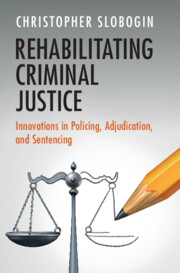Book contents
- Rehabilitating Criminal Justice
- Rehabilitating Criminal Justice
- Copyright page
- Contents
- Tables
- Preface
- Part I Policing
- Part II Adjudication
- Part III Post-conviction
- 9 Preventive Justice
- 10 Reconciling Desert and Risk at Sentencing
- 11 Specialized Criminal Courts
- 12 Abolitionism versus Minimalism
- Notes
- Index
10 - Reconciling Desert and Risk at Sentencing
from Part III - Post-conviction
Published online by Cambridge University Press: 17 April 2025
- Rehabilitating Criminal Justice
- Rehabilitating Criminal Justice
- Copyright page
- Contents
- Tables
- Preface
- Part I Policing
- Part II Adjudication
- Part III Post-conviction
- 9 Preventive Justice
- 10 Reconciling Desert and Risk at Sentencing
- 11 Specialized Criminal Courts
- 12 Abolitionism versus Minimalism
- Notes
- Index
Summary
Chapter 10 continues the examination of a sentencing system that emphasizes prevention over retribution. It does so by investigating Paul Robinson’s concept of “empirical desert,” the theory that a punishment system that closely tracks empirically derived lay views about how much punishment is deserved is a more efficient way of achieving crime prevention goals than alternative utilitarian approaches such as preventive justice. The chapter describes original studies that cast significant doubt on the most important hypotheses underlying empirical desert theory – to wit, that public consensus about “deserved” punishment exists; that departure from this consensus will result in noncompliance with the law; and that reducing this noncompliance through adhering to empirically derived desert will provide more effective crime control than a more explicit utilitarian regime. The chapter ends by suggesting that a preventive justice approach is more likely than a system based on empirical desert to reflect the public’s views on appropriate criminal dispositions and that this perceived legitimacy, in addition to the targeted prevention that preventive justice provides, is better at crime control.
- Type
- Chapter
- Information
- Rehabilitating Criminal JusticeInnovations in Policing, Adjudication, and Sentencing, pp. 159 - 187Publisher: Cambridge University PressPrint publication year: 2025

